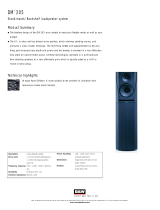
Sound Blaster Roar SR20A White Paper – Evolution, Concept and Tech Overview
16/4/2015 P
AGE 3 OF 20
Main Design Considerations
Through our many years of research in one-piece speaker systems, and countless in-
house research projects in our sound laboratories and listening rooms, Creative has
identified key usage patterns in the portable speaker category. We have also narrowed
down some major pitfalls in the design of today’s portable speaker.
Here are our findings:
1. Portable speakers are used both ‘near-field’ (meaning at the desk or on a bed) and
‘mid-far field’ (when used as a main stereo system in a studio apartment or at a
party or on a picnic)
2. Portable speakers are used when the listener is (most of the time) NOT at the
acoustical axis, meaning they are either standing up or walking around or using it
mostly for ambient or background music.
3. Portable speakers are often used and listened to (played back) at mid to soft
volume levels. In this case most designs lack “bass” when played at these levels.
4. Portable speakers are often impulse purchases (via heavy discount, brand hype or
for its industrial design), with sound quality being the lowest consideration. Most
portables have such poor fidelity; they hardly suffice to provide decent sound for
a bedroom.
As a result of these observations, we set out to configure and incorporate the following
design elements into a portable speaker that would excel in the portable speaker category:
1. Bi-Amplified Design -- Two Amps, Not One
Most portable speakers have a passive radiator -- meaning, it is not powered.
With this approach the passive system’s single amplifier must reproduce the
whole audio spectrum; low frequencies rapidly “use up” the amp’s headroom.
As higher frequencies ride along on lower frequency waveforms, they can be
distorted even when the high frequencies themselves will not be clipping. Having
two amps as opposed to one, the amp is free to drive each speaker to its safe
maximum limit and efficiency. It also allows greater power management of high
and low frequency. At lower volume playback bass is still evident. System also
plays louder without losing too much bass (common in many other portables).




















